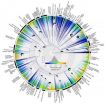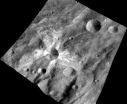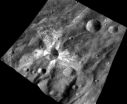(Press-News.org) New Haven, Conn. — A Yale-led scientific team has produced the most comprehensive family tree for birds to date, connecting all living bird species — nearly 10,000 in total — and revealing surprising new details about their evolutionary history and its geographic context.
Analysis of the family tree shows when and where birds diversified — and that birds' diversification rate has increased over the last 50 million years, challenging the conventional wisdom of biodiversity experts.
"It's the first time that we have — for such a large group of species and with such a high degree of confidence — the full global picture of diversification in time and space," said biologist Walter Jetz of Yale, lead author of the team's research paper, published Oct. 31 online in the journal Nature.
He continued: "The research highlights how heterogeneously fast diversifying species groups are distributed throughout the family tree and over geographic space. Many parts of the globe have seen a variety of species groups diversify rapidly and recently. All this leads to a diversification rate in birds that has been increasing over the past 50 million years."
The researchers relied heavily on fossil and DNA data, combining them with geographical information to produce the exhaustive family tree, which includes 9,993 species known to be alive now.
"The current zeitgeist in biodiversity science is that the world can fill up quickly," says biologist and co-author Arne Mooers of Simon Fraser University in Canada. "A new distinctive group, like bumblebees or tunafish, first evolves, and, if conditions are right, it quickly radiates to produce a large number of species. These species fill up all the available niches, and then there is nowhere to go. Extinction catches up, and things begin to slow down or stall. For birds the pattern is the opposite: Speciation is actually speeding up, not slowing down."
The researchers attribute the growing rate of avian diversity to an abundance of group-specific adaptations. They hypothesize that the evolution of physical or behavioral innovations in certain groups, combined with the opening of new habitats, has enabled repeated bursts of diversification. Another likely factor has been birds' exceptional mobility, researchers said, which time and again has allowed them to colonize new regions and exploit novel ecological opportunities.
In their analysis, the researchers also expose significant geographic differences in diversification rates. They are higher in the Western Hemisphere than in the Eastern, and higher on islands than mainlands. But surprisingly, they said, there is little difference in rates between the tropics and high latitudes. Regions of especially intense recent diversification include northern North American and Eurasia and southern South America.
"This was one of the big surprises," Jetz said. "For a long time biologists have thought that the vast diversity of tropical species must at least partly be due to greater rates of net species production there. For birds we find no support for this, and groups with fast and slow diversification appear to occur there as much as in the high latitudes. Instead, the answer may lie in the tropics' older age, leading to a greater accumulation of species over time. Global phylogenies like ours will allow further tests of this and other basic hypotheses about life on Earth."
###
Other authors are G.H. Thomas of the University of Bristol in the United Kingdom; J.B. Joy of Simon Fraser University in Canada; and K. Hartmann of the University of Tasmania in Australia.
The work was supported by the National Science Foundation, NASA, the Natural Environment Research Council (U.K), the Natural Sciences and Engineering Research Council of Canada, Simon Fraser University, and the Yale Institute of Biospheric Studies.
Exhaustive family tree for birds shows recent, rapid diversification
2012-11-01
ELSE PRESS RELEASES FROM THIS DATE:
First ever family tree for all living birds reveals evolution and diversification
2012-11-01
The world's first family tree linking all living bids and revealing when and where they evolved and diversified since dinosaurs walked the earth has been created by scientists from the University of Sheffield.
Experts used the family tree to map out where the almost 10,000 species of birds live to show where the most diversification has taken place in the world.
Researchers, from the University of Sheffield, Yale University, University of Tasmania and Simon Fraser University, say the creation of new species has speeded-up over the last 50 million years. Surprisingly, ...
High blood pressure damages the brain in early middle age
2012-11-01
Uncontrolled high blood pressure damages the brain's structure and function as early as young middle-age, and even the brains of middle-aged people who clinically would not be considered to have hypertension have evidence of silent structural brain damage, a study led by researchers at UC Davis has found.
The investigation found accelerated brain aging among hypertensive and prehypertensive individuals in their 40s, including damage to the structural integrity of the brain's white matter and the volume of its gray matter, suggesting that vascular brain injury "develops ...
Protoplanet Vesta: Forever young?
2012-11-01
Like a movie star constantly retouching her makeup, the protoplanet Vesta is continually stirring its outermost layer and presenting a young face.
New data from NASA's Dawn mission show that a common form of weathering that affects many airless bodies like Vesta in the inner solar system, including the moon, surprisingly doesn't age the protoplanet's outermost layer.
The data also indicate that carbon-rich asteroids have been splattering dark material on Vesta's surface over a long span of the body's history.
The findings are described in two papers published ...
Assembly not required
2012-11-01
Cambridge, Mass. - October 31, 2012 - Scientists have created new kinds of particles, 1/100th the diameter of a human hair, that spontaneously assemble themselves into structures resembling molecules made from atoms. These new particles come together, or "self-assemble," to form structures in patterns that were previously impossible to make and hold promise for manufacturing advanced optical materials and ceramics.
The method, described in the latest issue of the journal Nature, was developed by a team of chemists, chemical engineers, and physicists at New York University ...
Virtual reality 'beaming' technology transforms human-animal interaction
2012-11-01
Using cutting-edge virtual reality technology, researchers have 'beamed' a person into a rat facility allowing the rat and human to interact with each other on the same scale.
Published today in PLOS ONE, the research enables the rat to interact with a rat-sized robot controlled by a human participant in a different location. At the same time, the human participant (who is in a virtual environment) interacts with a human-sized avatar that is controlled by the movements of the distant rat. The authors hope the new technology will be used to study animal behaviour in ...
Global genome effort seeks genetic roots of disease
2012-11-01
By decoding the genomes of more than 1,000 people whose homelands stretch from Africa and Asia to Europe and the Americas, scientists have compiled the largest and most detailed catalog yet of human genetic variation. The massive resource will help medical researchers find the genetic roots of rare and common diseases in populations worldwide.
The 1000 Genomes Project involved some 200 scientists at Washington University School of Medicine in St. Louis and other institutions. Results detailing the DNA variations of individuals from 14 ethnic groups are published Oct. ...
Medical schools fall short on teaching students about obesity
2012-11-01
WINSTON-SALEM, N.C. – Oct. 31, 2012 -- It's no secret that obesity is a major problem in America.
More than one-third of adults and one-sixth of children are obese and it is one of the leading causes of preventable death. The costs associated with obesity are estimated at $99 million annually, comparable to the economic toll of cigarette smoking.
Despite all this, few U.S. medical schools are providing adequate, effective training on how to address weight issues in obese patients, according to researchers at Wake Forest Baptist Medical Center.
"Medical students are surrounded ...
New type of 'space weathering' observed on asteroid Vesta
2012-11-01
PROVIDENCE, R.I. [Brown University] — The surface of the giant asteroid Vesta is weathering in a way that appears to be completely different from any other asteroid yet visited, according to new data recorded by NASA's Dawn spacecraft. This new type of space weathering suggests that there's something about Vesta — perhaps its mineral composition or its position in the solar system — that makes its surface environment fundamentally different from other asteroids studied thus far.
The new data are presented in a paper published Nov. 1, 2012, in the journal Nature.
Space ...
Taming mavericks: Stanford researchers use synthetic magnetism to control light
2012-11-01
Magnetically speaking, photons are the mavericks of the engineering world. Lacking electrical charge, they are free to run even in the most intense magnetic fields. But all that may soon change. In a paper published in Nature Photonics, an interdisciplinary team from Stanford University reports that it has created a device that tames the flow of photons with synthetic magnetism.
The process breaks a key law of physics known as the time-reversal symmetry of light and could yield an entirely new class of devices that use light instead of electricity for applications ranging ...
OHSU researchers discover potential way to repair brain damage in multiple sclerosis
2012-11-01
PORTLAND, Ore. — Researchers at Oregon Health & Science University have discovered that blocking a certain enzyme in the brain can help repair the brain damage associated with multiple sclerosis and a range of other neurological disorders.
The discovery could have major implications for multiple sclerosis, complications from premature birth and other disorders and diseases caused by demyelination – a process where the insulation-like sheath surrounding nerve cells in the brain becomes damaged or destroyed. Demyelination disrupts the ability of nerve cells to communicate ...




